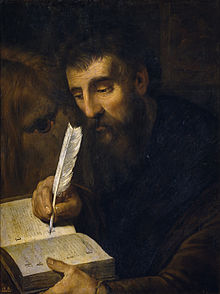Marku (ungjilltar)
Marku Ungjilltari | |
|---|---|
 Shën Marku Ungjilltari, vaj në kanavacë nga Artus Wolffort (shekulli i 17-të) | |
| Ungjilltar, Dëshmorë | |
| Lindur | rr. 12 AD Cyrene, Pentapolis i Afrikës së Veriut (sipas traditës koptike)[1] |
| Vdekur | rr. 68 AD (aged Stampa:C.) Alexandria, Egypt, Perandoria Romake |
| Nderuar në | Të gjitha kishat e krishtera që nderojnë shenjtorët |
| Vend i shenjtë | |
| Festa |
|
| Patronazhi | Barristers, Venice,[2] Egypt, Copts,[3] Mainar, Podgorica[4] |
| Vepra të konsiderueshme | Ungjilli i Markut (i atribuar) |
Marku Ungjilltar (greqisht: Μᾶρκος, romanizuar: Mârkos; latin: Marcus; koptisht: Μαρκοϲ; hebraisht: מרקוס) i njohur gjithashtu si Gjon Marku ose Shën Marku, është personi që tradicionalisht i atribuohet të jetë autori i Ungjillit të Markut. Studiuesit modernë të Biblës kanë arritur në përfundimin se Ungjilli i Markut është shkruar nga një autor anonim dhe jo nga Marku.[5][6][7][8] Sipas traditës së kishës, Marku themeloi selinë peshkopale të Aleksandrisë, e cila ishte një nga pesë selitë më të rëndësishme të krishterimit të hershëm. Dita e festës së tij festohet më 25 prill dhe simboli i tij është luani me krahë.[9]
Nderim
[Redakto | Redakto nëpërmjet kodit]Festa e Shën Markut festohet më 25 prill nga Kisha Katolike dhe Ortodokse Lindore. Për ato kisha që ende përdorin kalendarin Julian, 25 prilli sipas tij përputhet me 8 majin në kalendarin Gregorian deri në vitin 2099. Kisha Ortodokse Kopte kremton festën e Shën Markut më [Parmouti 30 (liturgjitë ortodokse kopte)|Parmouti 30]] sipas kalendarit koptik, i cili gjithmonë përputhet me 25 prillin në kalendarin Julian ose 8 maj në kalendarin Gregorian.
Aty ku Gjon Marku dallohet nga Marku Ungjilltar, Gjon Marku festohet më 27 shtator (si në Martirologjinë Romake) dhe Marku Ungjilltar më 25 prill.
Marku kujtohet në Kishën e Anglisë dhe në pjesën më të madhe të Kungimit Anglikan, me një Festival më 25 Prill.[10]
Referime
[Redakto | Redakto nëpërmjet kodit]- ^ "St. Mark The Apostle, Evangelist" (në anglisht). Coptic Orthodox Church Network. Marrë më 21 nëntor 2012.
- ^ Walsh, p. 21.
- ^ Lewis, Agnes Smith (2008). Through Cyprus (në anglisht). University of Michigan Press. fq. 65. ISBN 9780884022848.
St. Mark is the patron saint of the Copts.
- ^ "Markovdan: Slava Podgorice". Borba (në anglisht). 8 maj 2023.
- ^ E. P. Sanders (30 nëntor 1995). The Historical Figure of Jesus (në anglisht). Penguin Books Limited. fq. 103. ISBN 978-0-14-192822-7.
We do not know who wrote the gospels. They presently have headings: 'according to Matthew', 'according to Mark', 'according to Luke' and 'according to John'. The Matthew and John who are meant were two of the original disciples of Jesus. Mark was a follower of Paul, and possibly also of Peter; Luke was one of Paul's converts.5 These men – Matthew, Mark, Luke and John – really lived, but we do not know that they wrote gospels. Present evidence indicates that the gospels remained untitled until the second half of the second century.
- ^ Ehrman, Bart D. (2005). Lost Christianities: The Battles for Scripture and the Faiths We Never Knew (në anglisht). Oxford University Press. fq. 235. ISBN 978-0-19-518249-1.
Why then do we call them Matthew, Mark, Luke, and John? Because sometime in the second century, when proto-orthodox Christians recognized the need for apostolic authorities, they attributed these books to apostles (Matthew and John) and close companions of apostles (Mark, the secretary of Peter; and Luke, the traveling companion of Paul). Most scholars today have abandoned these identifications,11 and recognize that the books were written by otherwise unknown but relatively well-educated Greek-speaking (and writing) Christians during the second half of the first century.
- ^ Nickle, Keith Fullerton (1 janar 2001). The Synoptic Gospels: An Introduction (në anglisht). Westminster John Knox Press. fq. 43. ISBN 978-0-664-22349-6.
We must candidly acknowledge that all three of the Synoptic Gospels are anonymous documents. None of the three gains any importance by association with those traditional figures out of the life of the early church. Neither do they lose anything in importance by being recognized to be anonymous. Throughout this book the traditional names are used to refer to the authors of the first three Gospels, but we shall do so simply as a device of convenience.
- ^ Ehrman, Bart D. (1 nëntor 2004). Truth and Fiction in The Da Vinci Code : A Historian Reveals What We Really Know about Jesus, Mary Magdalene, and Constantine (në anglisht). Oxford University Press, USA. fq. 110–111. ISBN 978-0-19-534616-9.
We call these books, of course, Matthew, Mark, Luke, and John. And for centuries Christians have believed they were actually written by these people: two of the disciples of Jesus, Matthew the tax collector (see Matt. 9:9) and John, the "beloved disciple" (John 21:24), and two companions of the apostles, Mark, the secretary of Peter, and Luke, the traveling companion of Paul. These are, after all, the names found in the titles of these books. But what most people don't realize is that these titles were added later, by second-century Christians, decades after the books themselves had been written, in order to be able to claim that they were apostolic in origin. Why would later Christians do this? Recall our earlier discussion of the formation of the New Testament canon: only those books that were apostolic could be included. What was one to do with Gospels that were widely read and accepted as authoritative but that in fact were written anonymously, as all four of the New Testament Gospels were? They had to be associated with apostles in order to be included in the canon, and so apostolic names were attached to them.
- ^ Senior, Donald P. (1998), "Mark", përmbledhur nga Ferguson, Everett (red.), Encyclopedia of Early Christianity (në anglisht) (bot. 2nd), New York and London: Garland Publishing, Inc., fq. 720, ISBN 0-8153-3319-6
- ^ "The Calendar". The Church of England (në anglisht). Marrë më 2021-03-27.
